Jianxiong Pan
Step1X-3D: Towards High-Fidelity and Controllable Generation of Textured 3D Assets
May 12, 2025Abstract:While generative artificial intelligence has advanced significantly across text, image, audio, and video domains, 3D generation remains comparatively underdeveloped due to fundamental challenges such as data scarcity, algorithmic limitations, and ecosystem fragmentation. To this end, we present Step1X-3D, an open framework addressing these challenges through: (1) a rigorous data curation pipeline processing >5M assets to create a 2M high-quality dataset with standardized geometric and textural properties; (2) a two-stage 3D-native architecture combining a hybrid VAE-DiT geometry generator with an diffusion-based texture synthesis module; and (3) the full open-source release of models, training code, and adaptation modules. For geometry generation, the hybrid VAE-DiT component produces TSDF representations by employing perceiver-based latent encoding with sharp edge sampling for detail preservation. The diffusion-based texture synthesis module then ensures cross-view consistency through geometric conditioning and latent-space synchronization. Benchmark results demonstrate state-of-the-art performance that exceeds existing open-source methods, while also achieving competitive quality with proprietary solutions. Notably, the framework uniquely bridges the 2D and 3D generation paradigms by supporting direct transfer of 2D control techniques~(e.g., LoRA) to 3D synthesis. By simultaneously advancing data quality, algorithmic fidelity, and reproducibility, Step1X-3D aims to establish new standards for open research in controllable 3D asset generation.
WaveFill: A Wavelet-based Generation Network for Image Inpainting
Jul 23, 2021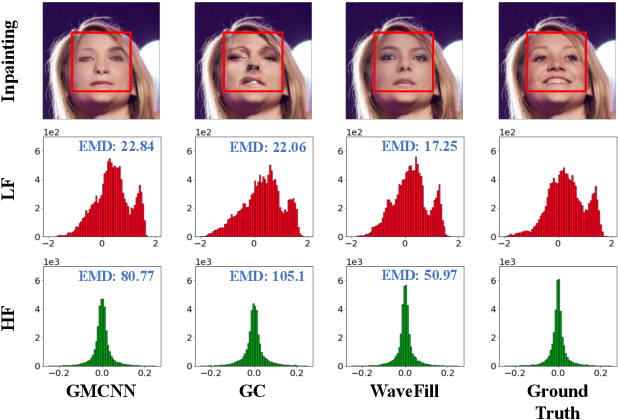

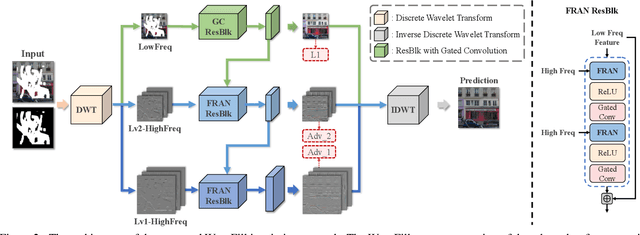
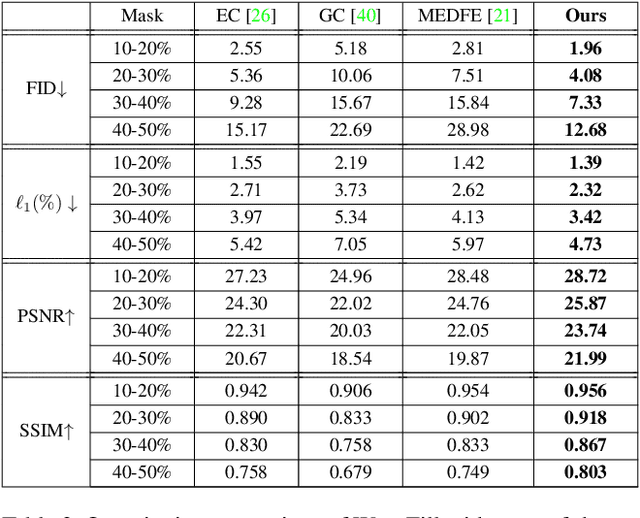
Abstract:Image inpainting aims to complete the missing or corrupted regions of images with realistic contents. The prevalent approaches adopt a hybrid objective of reconstruction and perceptual quality by using generative adversarial networks. However, the reconstruction loss and adversarial loss focus on synthesizing contents of different frequencies and simply applying them together often leads to inter-frequency conflicts and compromised inpainting. This paper presents WaveFill, a wavelet-based inpainting network that decomposes images into multiple frequency bands and fills the missing regions in each frequency band separately and explicitly. WaveFill decomposes images by using discrete wavelet transform (DWT) that preserves spatial information naturally. It applies L1 reconstruction loss to the decomposed low-frequency bands and adversarial loss to high-frequency bands, hence effectively mitigate inter-frequency conflicts while completing images in spatial domain. To address the inpainting inconsistency in different frequency bands and fuse features with distinct statistics, we design a novel normalization scheme that aligns and fuses the multi-frequency features effectively. Extensive experiments over multiple datasets show that WaveFill achieves superior image inpainting qualitatively and quantitatively.
Unbalanced Feature Transport for Exemplar-based Image Translation
Jun 19, 2021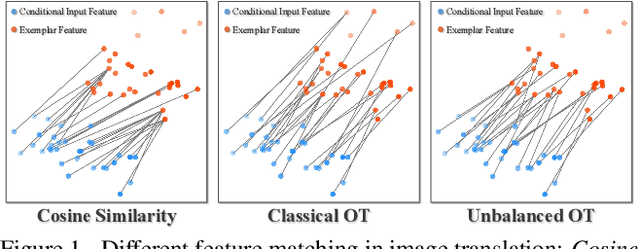

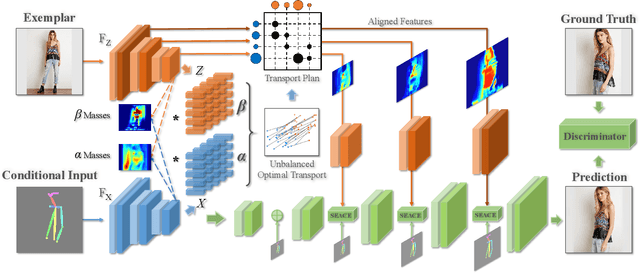
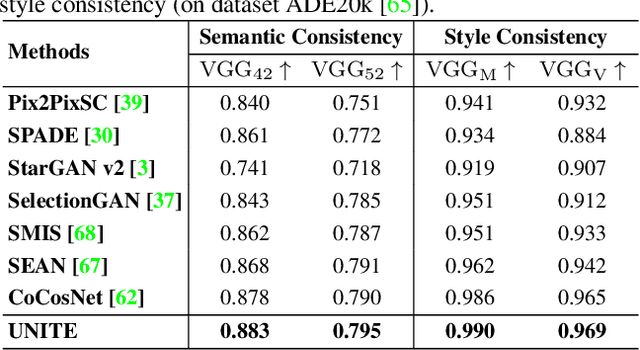
Abstract:Despite the great success of GANs in images translation with different conditioned inputs such as semantic segmentation and edge maps, generating high-fidelity realistic images with reference styles remains a grand challenge in conditional image-to-image translation. This paper presents a general image translation framework that incorporates optimal transport for feature alignment between conditional inputs and style exemplars in image translation. The introduction of optimal transport mitigates the constraint of many-to-one feature matching significantly while building up accurate semantic correspondences between conditional inputs and exemplars. We design a novel unbalanced optimal transport to address the transport between features with deviational distributions which exists widely between conditional inputs and exemplars. In addition, we design a semantic-activation normalization scheme that injects style features of exemplars into the image translation process successfully. Extensive experiments over multiple image translation tasks show that our method achieves superior image translation qualitatively and quantitatively as compared with the state-of-the-art.
Diverse Image Inpainting with Bidirectional and Autoregressive Transformers
Apr 30, 2021
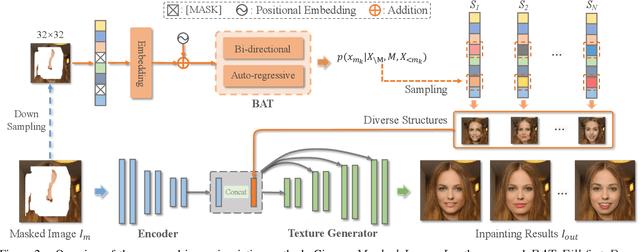
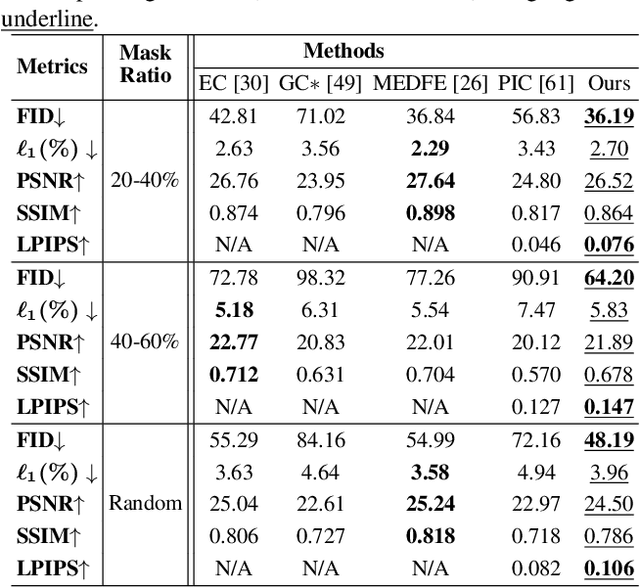
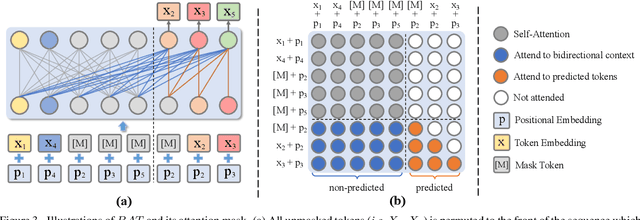
Abstract:Image inpainting is an underdetermined inverse problem, it naturally allows diverse contents that fill up the missing or corrupted regions reasonably and realistically. Prevalent approaches using convolutional neural networks (CNNs) can synthesize visually pleasant contents, but CNNs suffer from limited perception fields for capturing global features. With image-level attention, transformers enable to model long-range dependencies and generate diverse contents with autoregressive modeling of pixel-sequence distributions. However, the unidirectional attention in transformers is suboptimal as corrupted regions can have arbitrary shapes with contexts from arbitrary directions. We propose BAT-Fill, an image inpainting framework with a novel bidirectional autoregressive transformer (BAT) that models deep bidirectional contexts for autoregressive generation of diverse inpainting contents. BAT-Fill inherits the merits of transformers and CNNs in a two-stage manner, which allows to generate high-resolution contents without being constrained by the quadratic complexity of attention in transformers. Specifically, it first generates pluralistic image structures of low resolution by adapting transformers and then synthesizes realistic texture details of high resolutions with a CNN-based up-sampling network. Extensive experiments over multiple datasets show that BAT-Fill achieves superior diversity and fidelity in image inpainting qualitatively and quantitatively.
 Add to Chrome
Add to Chrome Add to Firefox
Add to Firefox Add to Edge
Add to Edge